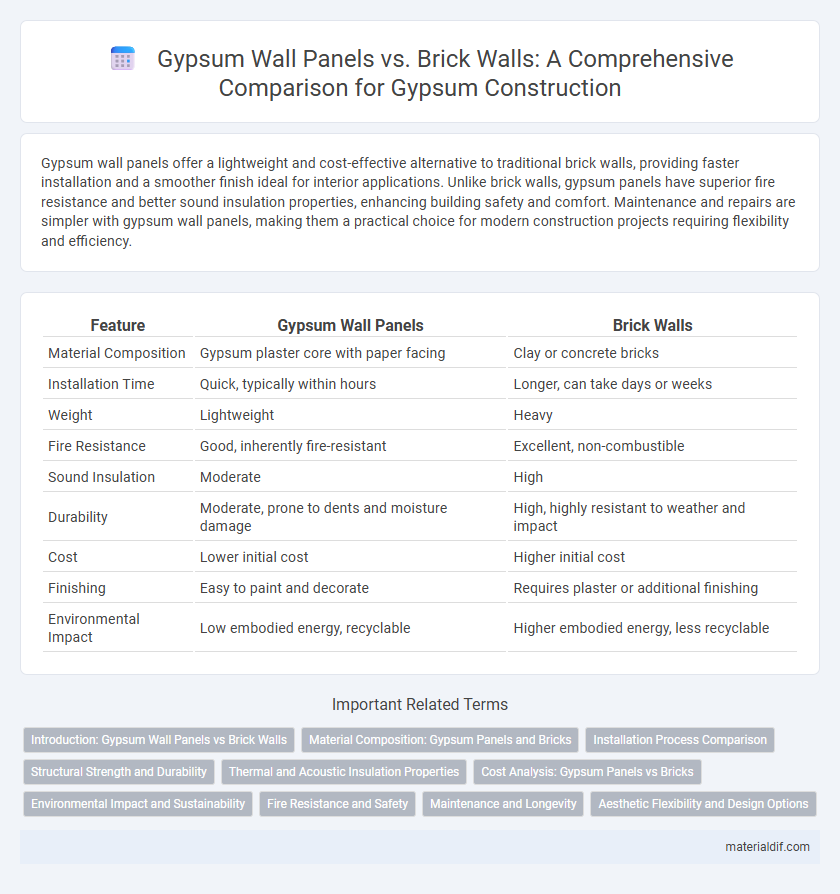Gypsum wall panels offer a lightweight and cost-effective alternative to traditional brick walls, providing faster installation and a smoother finish ideal for interior applications. Unlike brick walls, gypsum panels have superior fire resistance and better sound insulation properties, enhancing building safety and comfort. Maintenance and repairs are simpler with gypsum wall panels, making them a practical choice for modern construction projects requiring flexibility and efficiency.
Table of Comparison
| Feature | Gypsum Wall Panels | Brick Walls |
|---|---|---|
| Material Composition | Gypsum plaster core with paper facing | Clay or concrete bricks |
| Installation Time | Quick, typically within hours | Longer, can take days or weeks |
| Weight | Lightweight | Heavy |
| Fire Resistance | Good, inherently fire-resistant | Excellent, non-combustible |
| Sound Insulation | Moderate | High |
| Durability | Moderate, prone to dents and moisture damage | High, highly resistant to weather and impact |
| Cost | Lower initial cost | Higher initial cost |
| Finishing | Easy to paint and decorate | Requires plaster or additional finishing |
| Environmental Impact | Low embodied energy, recyclable | Higher embodied energy, less recyclable |
Introduction: Gypsum Wall Panels vs Brick Walls
Gypsum wall panels offer lightweight, fire-resistant, and quick-installation advantages compared to traditional brick walls, which provide superior durability, sound insulation, and thermal mass. Gypsum panels are commonly used in modern construction for interior partitions due to their smooth surface and ease of finishing, while brick walls excel in exterior applications and load-bearing structures. The choice between gypsum panels and brick walls depends on factors like construction speed, cost efficiency, insulation needs, and structural requirements.
Material Composition: Gypsum Panels and Bricks
Gypsum wall panels are primarily composed of calcium sulfate dihydrate, offering a lightweight and fire-resistant material with smooth surface finishes ideal for interior applications. Brick walls consist of fired clay or shale, providing high compressive strength, thermal mass, and durability for structural and exterior uses. The difference in material composition directly influences their performance, insulation properties, moisture resistance, and installation methods in building construction.
Installation Process Comparison
Gypsum wall panels offer a significantly faster installation process compared to brick walls, often reducing construction time by up to 50% due to their lightweight nature and prefabricated design. Unlike brick walls that require skilled masonry work, curing time, and mortar application, gypsum panels can be quickly mounted on metal or wooden frames with screws and joint compound, streamlining labor efforts. The minimal dust and waste generated during gypsum panel installation also enhance site cleanliness and improve overall project efficiency.
Structural Strength and Durability
Gypsum wall panels offer lightweight construction with moderate structural strength suitable for non-load bearing partitions, while brick walls provide exceptional load-bearing capacity and long-term durability. Brick walls resist environmental elements such as moisture and fire more effectively than gypsum panels, contributing to enhanced longevity in structural applications. The choice between gypsum panels and brick walls depends on the specific requirements for structural support, insulation, and lifespan in building projects.
Thermal and Acoustic Insulation Properties
Gypsum wall panels offer superior thermal insulation compared to brick walls due to their lower thermal conductivity, which helps maintain consistent indoor temperatures and reduces energy consumption. In terms of acoustic insulation, gypsum panels provide effective sound absorption, minimizing noise transmission within spaces, although dense brick walls generally provide better soundproofing against external noise. Choosing gypsum panels enhances energy efficiency and interior sound quality, while brick walls excel at blocking outdoor noise.
Cost Analysis: Gypsum Panels vs Bricks
Gypsum wall panels typically offer a lower initial cost compared to brick walls, with material and labor expenses reduced by up to 40%. Installation of gypsum panels is faster, cutting down labor costs and minimizing overall project timelines. However, brick walls provide superior durability and long-term value, which may justify higher upfront investments depending on the building requirements.
Environmental Impact and Sustainability
Gypsum wall panels offer a significantly lower environmental impact compared to brick walls due to their energy-efficient manufacturing process and high recyclability, reducing landfill waste. They contribute to better indoor air quality by regulating humidity and containing minimal volatile organic compounds (VOCs), unlike brick walls that often require additional treatments with environmental trade-offs. Sustainable sourcing of gypsum and the potential for reuse in new panels enhance the overall lifecycle sustainability, making gypsum wall panels a greener choice for modern construction projects.
Fire Resistance and Safety
Gypsum wall panels offer superior fire resistance compared to traditional brick walls due to their inherent non-combustible calcium sulfate dihydrate composition, which slows heat transfer and prevents fire spread. Gypsum panels typically achieve fire ratings up to 1-2 hours, meeting stringent building codes designed for fire safety in residential and commercial structures. Brick walls, while durable, lack the same fire-retarding properties, often requiring additional treatments to enhance their fire resistance and overall safety.
Maintenance and Longevity
Gypsum wall panels generally require less maintenance than brick walls due to their resistance to cracking and easy repair with minimal effort. Brick walls offer superior longevity, often lasting over 100 years with proper upkeep, while gypsum panels typically have a lifespan of 10-20 years before replacement is needed. Moisture sensitivity makes gypsum panels prone to damage in damp conditions, whereas bricks provide better durability in various weather environments.
Aesthetic Flexibility and Design Options
Gypsum wall panels offer superior aesthetic flexibility and extensive design options compared to traditional brick walls, allowing for smooth finishes, a variety of textures, and customizable shapes. These panels can be easily painted, wallpapered, or textured to match diverse interior styles, while brick walls are limited by their rigid, rustic appearance. Gypsum panels also enable faster installation and adaptation for modern architectural elements like curves and embedded lighting.
Gypsum wall panels vs Brick walls Infographic

 materialdif.com
materialdif.com